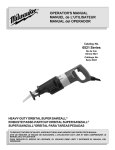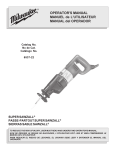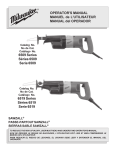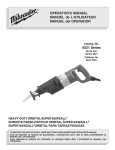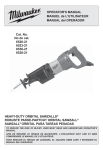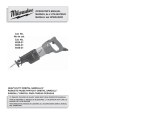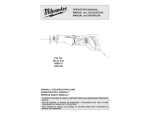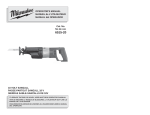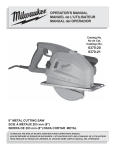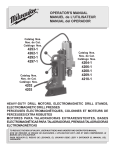Download Milwaukee 6521 Series Operator`s manual
Transcript
OPERATOR'S MANUAL MANUEL de L'UTILISATEUR MANUAL del OPERADOR Catalog No. 6521 Series No de Cat. Séries 6521 Catálogo No. Serie 6521 HEAVY-DUTY ORBITAL SUPER SAWZALL® ROBUSTE PASSE-PARTOUT ORBITAL SUPER SAWZALL® SUPER SAWZALL®ORBITAL PARA TAREAS PESADAS TO REDUCE THE RISK OF INJURY, USER MUST READ AND UNDERSTAND OPERATOR'S MANUAL. AFIN DE RÉDUIRE LE RISQUE DE BLESSURES, L'UTILISATEUR DOIT LIRE ET BIEN COMPRENDRE LE MANUEL DE L'UTILISATEUR. PARA REDUCIR EL RIESGO DE LESIONES, EL USUARIO DEBE LEER Y ENTENDER EL MANUAL DEL OPERADOR. page 2 GENERAL SAFETY RULES — FOR ALL POWER TOOLS WARNING! READ ALL INSTRUCTIONS Failure to follow all instructions listed below may result in electric shock, fire and/or serious injury. The term "power tool" in all of the warnings listed below refers to your mains-operated (corded) power tool or battery-opearted (cordless) power tool. SAVE THESE INSTRUCTIONS WORK AREA SAFETY 1. Keep work area clean and well lit. Cluttered or dark areas invite accidents. 2. Do not operate power tools in explosive atmospheres, such as in the presence of flammable liquids, gases, or dust. Power tools create sparks which may ignite the dust or fumes. 3. Keep children and bystanders away while operating a power tool. Distractions can cause you to lose control. ELECTRICAL SAFETY 4. Power tool plugs must match the outlet. Never modify the plug in any way. Do not use any adapter plugs with earthed (grounded) power tools. Unmodified plugs and matching outlets will reduce risk of electric shock. 5. Avoid body contact with earthed or grounded surfaces such as pipes, radiators, ranges and refrigerators. There is an increased risk of electric shock if your body is earthed or grounded. 6. Do not expose power tools to rain or wet conditions. Water entering a power tool will increase the risk of electric shock. 7. Do not abuse the cord. Never use the cord for carrying, pulling, or unplugging the power tool. Keep cord away from heat, oil, sharp edges, or moving parts. Damaged or entangled cords increase the risk of electric shock. 8. When operating a power tool outdoors, use an extension cord suitable for outdoor use. Use of a cord suitable for outdoor use reduces the risk of electric shock. PERSONAL SAFETY POWER TOOL USE AND CARE 16. Do not force the power tool. Use the correct power tool for your application. The correct power tool will do the job better and safer at the rate for which it was designed. 17. Do not use the power tool if the switch does not turn it on and off. Any power tool that cannot be controlled with the switch is dangerous and must be repaired. 18. Disconnect the plug from the power source and/or the battery pack from the power tool before making any adjustments, changing accessories, or storing power tools. Such preventive safety measures reduce the risk of starting the tool accidentally. 19. Store idle power tools out of the reach of children and do not allow persons unfamiliar with the power tools or these instructions to operate power tools. Power tools are dangerous in the hands of untrained users. 20. Maintain power tools. Check for misalignment or binding of moving parts, breakage of parts and any other condition that may affect the power tool's operation. If damaged, have the power tool repaired before use. Many accidents are caused by poorly maintained power tools. 21. Keep cutting tools sharp and clean. Properly maintained cutting tools with sharp cutting edges are less likely to bind and are easier to control. 22. Use the power tool, accessories and tool bits etc., in accordance with these instructions and in the manner intended for the particular type of power tool, taking into account the working conditions and the work to be performed. Use of the power tool for operations different from those intended could result in a hazardous situation. SERVICE 9. Stay alert, watch what you are doing and use common sense when operating a power tool. Do not use a power tool while you are tired or under the influence of drugs, alcohol or medication. A moment of inattention while operating power tools may result in serious personal injury. 23. Have your power tool serviced by a qualified repair person using only identical replacement parts. This will ensure that the safety of the power tool is maintained. 10. Use safety equipment. Always wear eye protection. Safety equipment such as dust mask, non-skid safety shoes, hard hat, or hearing protection used for appropriate conditions will reduce personal injuries. 11. Avoid accidental starting. Ensure the switch is in the offposition before plugging in. Carrying tools with your finger on the switch or plugging in power tools that have the switch on invites accidents. 12. Remove any adjusting key or wrench before turning the power tool on. A wrench or a key left attached to a rotating part of the power tool may result in personal injury. 13. Do not overreach. Keep proper footing and balance at all times. This enables better control of the power tool in unexpected situations. 14. Dress properly. Do not wear loose clothing or jewellery. Keep your hair, clothing and gloves away from moving parts. Loose clothes, jewellery, or long hair can be caught in moving parts. 15. If devices are provided for the connection of dust extraction and collection facilities, ensure these are connected and properly used. Use of these devices can reduce dust-related hazards. page 3 SPECIFIC SAFETY RULES — SAWZALLS® 1. Hold power tools by insulated gripping surfaces when performing an operation where the cutting tool may contact hidden wiring or its own cord. Contact with a "live" wire will make exposed metal parts of the tool "live" and shock the operator. 2. Keep hands away from all cutting edges and moving parts. 3. Use clamps or another practical way to secure and support the workpiece to a stable platform. Holding the work by hand or against your body leaves it unstable and may lead to loss of control. 3. Maintain labels and nameplates. These carry important information. If unreadable or missing, contact a MILWAUKEE service facility for a free replacement. 4. WARNING! Some dust created by power sanding, sawing, grinding, drilling, and other construction activities contains chemicals known to cause cancer, birth defects or other reproductive harm. Some examples of these chemicals are: • lead from lead-based paint • crystalline silica from bricks and cement and other masonry products, and • arsenic and chromium from chemically-treated lumber. Your risk from these exposures varies, depending on how often you do this type of work. To reduce your exposure to these chemicals: work in a well ventilated area, and work with approved safety equipment, such as those dust masks that are specially designed to filter out microscopic particles. Symbology Specifications Double Insulated Volts Length of Strokes Catalog AC Only Amps Stroke per Minute No. Volts Alternating Current 6521 Series 120 11 1-1/4" 0-3200 Amps No Load Strokes Per Minute Underwriters Laboratories, Inc. Canadian Standards Association Straight Cut Orbital Cut FUNCTIONAL DESCRIPTION 2 1 3 11 1. Nameplate 2. Handle 3. Trigger 10 4 ® 4. Quik-Lok Cord (select models) 5. Speed control dial 6. Insulating boot 7. Shoe release lever 8. Adjustable pivot shoe 9. Blade 10. Blade clamp 11. Orbit control switch page 4 5 6 7 8 9 GROUNDING EXTENSION CORDS WARNING! Improperly connecting the grounding wire can result in the risk of electric shock. Check with a qualified electrician if you are in doubt as to whether the outlet is properly grounded. Do not modify the plug provided with the tool. Never remove the grounding prong from the plug. Do not use the tool if the cord or plug is damaged. If damaged, have it repaired by a MILWAUKEE service facility before use. If the plug will not fit the outlet, have a proper outlet installed by a qualified electrician. Grounded tools require a three wire extension cord. Double insulated tools can use either a two or three wire extension cord. As the distance from the supply outlet increases, you must use a heavier gauge extension cord. Using extension cords with inadequately sized wire causes a serious drop in voltage, resulting in loss of power and possible tool damage. Refer to the table shown to determine the required minimum wire size. The smaller the gauge number of the wire, the greater the capacity of the cord. For example, a 14 gauge cord can carry a higher current than a 16 gauge cord. When using more than one extension cord to make up the total length, be sure each cord contains at least the minimum wire size required. If you are using one extension cord for more than one tool, add the nameplate amperes and use the sum to determine the required minimum wire size. Guidelines for Using Extension Cords Grounded Tools: Tools with Three Prong Plugs Tools marked “Grounding Required” have a three wire cord and three prong grounding plug. The plug must be connected to a properly grounded outlet (See Figure A). If the tool should electrically malfunction or break down, grounding provides a low resistance path to carry electricity away from the user, reducing the risk of electric shock. If you are using an extension cord outdoors, be sure it is marked with the suffix “W-A” (“W” in Canada) to indicate that it is acceptable for outdoor use. • Be sure your extension cord is properly wired and in good electrical condition. Always replace a damaged extension cord or have it repaired by a qualified person before using it. • Protect your extension cords from sharp objects, excessive heat and damp or wet areas. Recommended Minimum Wire Gauge for Extension Cords* Fig. A The grounding prong in the plug is connected through the green wire inside the cord to the grounding system in the tool. The green wire in the cord must be the only wire connected to the tool's grounding system and must never be attached to an electrically “live” terminal. Your tool must be plugged into an appropriate outlet, properly installed and grounded in accordance with all codes and ordinances. The plug and outlet should look like those in Figure A. Double Insulated Tools: Tools with Two Prong Plugs Tools marked “Double Insulated” do not require grounding. They have a special double insulation system which satisfies OSHA requirements and complies with the applicable standards of Underwriters Laboratories, Inc., the Canadian Standard Association and the National Electrical Code. Double Insulated tools may be used in either of the 120 volt outlets shown in Figures B and C. • Nameplate Amperes 0-5 5.1 - 8 8.1 - 12 12.1 - 15 15.1 - 20 Extension Cord Length 25' 50' 75' 100' 150' 200' 16 16 14 12 10 16 16 14 12 10 16 14 12 10 10 14 12 10 10 -- 12 10 ---- 12 ----- * Based on limiting the line voltage drop to five volts at 150% of the rated amperes. READ AND SAVE ALL INSTRUCTIONS FOR FUTURE USE. Fig. B Fig. C page 5 TOOL ASSEMBLY WARNING! To reduce the risk of injury, always unplug tool before attaching or removing accessories or making adjustments. Use only specifically recommended accessories. Others may be hazardous. Quik-Lok ® Blade Clamp Maintenance • Periodically clean dust and debris from the Quik-Lok® Blade Clamp with dry compressed air. • If the collar resists twisting, twist the collar back and forth to shake debris loose. • Periodically lubricate Quik-Lok® Blade Clamp with a dry lubricant such as graphite. Removing and Replacing the Quik-Lok® Cord (Fig. 1) Removing broken blades from the Quik-Lok ® Blade Clamp Fig. 1 Unplug the tool before removing blades. Broken blades can be removed by the following methods. 1. To remove the Quik-Lok® Cord, turn the cord nut 1/4 turn to the left and pull it out. 2. To replace the Quik-Lok® Cord, align the connector keyways and push the connector in as far as it will go. Turn the cord nut 1/4 turn to the right to lock. ® Use MILWAUKEE Sawzall Blades for best performance. When selecting a blade, choose the right type and length. Many types of blades are available for a variety of applications: cutting metal, wood, nail-embedded wood, scroll cutting, roughing-in, and contours. Many lengths are also available. Choose a length long enough to extend beyond the shoe and your work throughout the stroke. Do not use blades less than 3-1/2" long since they won't extend beyond the shoe throughout the stroke. For best performance and longest life, see “Accessories” to select the best blade for the job. Quik-Lok ® Blade Clamp (Fig. 2) Unplug the tool before changing blades. Be sure the spindle and blade clamp areas are clean. Metal chips and sawdust may prevent the Quik-Lok® Blade Clamp from clamping securely. Collar Blade 1. Depending on the job, the blade may be inserted with the teeth facing up or down. To install a blade, twist collar in the direction of the arrow while inserting the blade into the clamp until the tang butts against the collar. 2. Release collar and the spring loaded mechanism will clamp the blade firmly in place. 3. Twist collar in the opposite direction of the arrow to ensure that the blade is locked into the clamp. 4. Tug on blade to make sure it is securely locked in place. 5. To remove a blade, twist collar in the direction of the arrow while pulling on the blade. Be careful when handling hot blades. page 6 Point the tool downward, twist the collar, and shake the tool up and down (DO NOT turn the tool on while your fingers are holding the blade clamp open). The shank of the broken blade should drop out of the clamp. • If shaking the tool doesn't work... In most cases, a corner of the broken blade will extend beyond the blade clamp. Simply twist the collar and pull the broken blade out of the clamp by this corner. • Selecting a Blade Fig. 2 • If the broken stub doesn't extend far enough to be grabbed by its corner, use a thin blade with small teeth (such as a metal cutting blade) to hook the blade that is jammed in the clamp while twisting the collar and pull it out. OPERATION WARNING! To reduce the risk of injury, wear safety goggles or glasses with side shields. Adjustable Pivot Shoe (Fig. 3) The shoe can be adjusted forward or backward to six positions to take advantage of the unused portion of the blade or for special jobs requiring low blade clearance. Fig. 3 Impact Protection System Select models are equipped with a unique patented gearing system that provides efficient power transmission and extended life in the most difficult cutting applications. This durable system will absorb impacts, blade lock ups, and motor stalls. These models can be used for extreme cutting applications such as large diameter pipe, thick metal, pallets, and heavy demolition and renovation work as well as for general purpose cutting. Starting, Stopping and Controlling Speed 1. To start the tool, grasp the handle firmly and pull the trigger. 2. To stop the tool, release the trigger. Allow the tool to come to a complete stop before removing the blade from a partial cut or laying the tool down. Orbit Control Switch (Fig. 5) The Orbital Super Sawzall® is equipped with an orbit control switch. The tool may be operated in straight reciprocating (non orbital) or orbital action. Straight reciprocating action should be used when a smooth cut is needed. Orbital action is recommended for fast, aggressive cutting. The optimum orbital action should be determined by the user for their specific cutting requirements. Fig. 5 1/4 Turn 1. 1 To adjust the shoe, pull the shoe release lever down 1/4 turn and slide the shoe forward or backward to the desired position. 2. To lock the shoe in position, push the shoe release lever up. 3. After adjusting the shoe, slowly pull the trigger to be sure the blade always extends beyond the shoe and your work throughout the stroke. DO NOT OPERATE SAWZALL WITHOUT SHOE. STRIKING THE SPINDLE AGAINST WORK MAY DAMAGE THE RECIPROCATING MECHANISM. WARNING! To reduce the risk of injury, be sure the blade always extends beyond the shoe and work throughout the stroke. Blades may shatter if they impact the work or shoe (Fig. 4). 2 1. For straight reciprocating action, move the orbit control switch to the straight cut symbol (1). 2. For orbital action, move the orbit control switch towards the orbital cut symbol (2). Fig. 4 Stroke The amount of orbital action may be adjusted by moving the orbital control switch to any position between the two symbols. For larger orbital action, move the orbit control switch closer to the orbital cut symbol (2). For smaller orbital action, move the orbit control switch closer to the straight cut symbol (1). Orbital action may be adjusted when the tool is running. NOTE: Orbital action will not operate if the blade is installed with the teeth facing upward. page 7 Selecting the Speed Range Fig. 6 The speed control dial controls the maximum strokes per minute. The speed will remain variable to the chosen dial setting by use of the trigger switch. Refer to the chart for recommended dial settings. MATERIAL SUGGESTED DIAL SETTINGS* Mild Steel 2-3 Wood 5 Nail-Embedded Wood 5 Stainless Steel 1-3 Drywall 4-5 Fiberglass 1-3 Plastics 1-3 Cast Iron 2-3 Non-Ferrous Metals 2-3 * These are only suggested settings; the actual optimum setting may vary depending on line voltage, blade selected and user preference. 1. Trigger Speed Control Switch Super Sawzalls® are equipped with a trigger speed control switch. It may be operated at any speed from zero strokes per minute to full speed. Always start tool before blade contacts the workpiece. To vary the speed, simply increase or decrease the pressure on the trigger. The further the trigger is pulled, the greater the speed. To stop the tool, release the trigger and allow the tool to stop completely before removing from a partial cut or before laying the tool down. General Cutting For straight or contour cutting from an edge, line the blade up with your cutting line. Before the blade contacts the workpiece, grasp the handle firmly and pull the trigger. Then guide the tool along your cutting line. Always hold the shoe flat against the workpiece to avoid excessive vibration. Cutting Metals Begin cutting at a slow speed, gradually increasing speed as you cut. When cutting into metals or hard materials that can not be cut from an edge, drill a starting hole larger than the widest part of the blade. Extend blade life by using a solid blade cutting lubricant such as MILWAUKEE Band Saw Blade Lubricant Cat. No. 49-08-4206. Plunge Cutting (Fig. 6) Your MILWAUKEE Sawzall® is ideal for plunge cutting directly into surfaces that can not be cut from an edge, such as walls or floors. Orbital action is recommended for plunge cutting. Plunge cutting may be done two ways depending on how the blade is inserted. Column A shows how to plunge cut with the teeth of the blade facing down. Column B shows how to plunge cut with the teeth of the blade facing up. NOTE: Orbital action will not operate if the blade is installed with the teeth facing upward. Do not plunge cut into metal surfaces (see “Cutting Metals”). page 8 Insert the blade into the tool. If you inserted the blade with the teeth facing downward, hold the tool as shown in Column A, resting the edge of the shoe on the workpiece. If you inserted the blade with the teeth facing upward, hold the tool as shown in Column B, resting the edge of the shoe on the workpiece as shown. 2. With the blade just above the workpiece, pull the trigger. Using the edge of the shoe as a pivot, lower the blade into the workpiece as shown. 3. As the blade starts cutting, raise the handle of the tool slowly until the shoe rests firmly on the workpiece. Then guide the tool along your cutting line to acquire the desired cut. NOTE: To make plunge cutting easier, use a heavy gauge blade and install the blade with the teeth facing upward as shown in Column B. WARNING! To reduce the risk of explosion, electric shock and property damage, always check the work area for hidden gas pipes, electrical wires or water pipes when making blind or plunge cuts. MAINTENANCE WARNING! To reduce the risk of injury, always unplug your tool before performing any maintenance. Never disassemble the tool or try to do any rewiring on the tool's electrical system. Contact a MILWAUKEE service facility for ALL repairs. Maintaining Tools Keep your tool in good repair by adopting a regular maintenance program. Before use, examine the general condition of your tool. Inspect guards, switches, tool cord set and extension cord for damage. Check for loose screws, misalignment, binding of moving parts, improper mounting, broken parts and any other condition that may affect its safe operation. If abnormal noise or vibration occurs, turn the tool off immediately and have the problem corrected before further use. Do not use a damaged tool. Tag damaged tools “DO NOT USE” until repaired (see “Repairs”). Under normal conditions, relubrication is not necessary until the motor brushes need to be replaced. After six months to one year, depending on use, return your tool to the nearest MILWAUKEE service facility for the following: • WARNING! To reduce the risk of injury, electric shock and damage to the tool, never immerse your tool in liquid or allow a liquid to flow inside the tool. Cleaning Clean dust and debris from vents. Keep the tool handles clean, dry and free of oil or grease. Use only mild soap and a damp cloth to clean your tool since certain cleaning agents and solvents are harmful to plastics and other insulated parts. Some of these include: gasoline, turpentine, lacquer thinner, paint thinner, chlorinated cleaning solvents, ammonia and household detergents containing ammonia. Never use flammable or combustible solvents around tools. Repairs If your tool is damaged, return the entire tool to the nearest service center. Lubrication • Brush inspection and replacement • Mechanical inspection and cleaning (gears, spindles, bearings, housing, etc.) • Electrical inspection (switch, cord, armature, etc.) • Testing to assure proper mechanical and electrical operation ACCESSORIES WARNING! To reduce the risk of injury, always unplug the tool before attaching or removing accessories. Use only specifically recommended accessories. Others may be hazardous. For a complete listing of accessories refer to your MILWAUKEE Electric Tool catalog or go on-line to www.milwaukeetool.com. To obtain a catalog, contact your local distributor or a service center. Quik-Lok® Cord Sets 10' Quik-Lok® Cord Cat. No. 48-76-5010 25' Quik-Lok® Cord Cat. No. 48-76-5025 Select Models: Blade Clamp Cat. No. 42-68-0682 Blade Clamp Screw Cat. No. 06-83-2975 “787” Blades: Blade Clamp Cat. No. 42-68-0685 Blade Clamp Screw Cat. No. 06-83-2975 See Pages 24, 25 & 26 for a listing of Super Sawzall® Blades. FIVE YEAR TOOL LIMITED WARRANTY Every MILWAUKEE tool is tested before leaving the factory and is warranted to be free from defects in material and workmanship. MILWAUKEE will repair or replace (at MILWAUKEE’s discretion), without charge, any tool (including battery chargers) which examination proves to be defective in material or workmanship from five (5) years after the date of purchase. Return the tool and a copy of the purchase receipt or other proof of purchase to a MILWAUKEE Factory Service/Sales Support Branch location or MILWAUKEE Authorized Service Station, freight prepaid and insured. This warranty does not cover damage from repairs made or attempted by other than MILWAUKEE authorized personnel, abuse, normal wear and tear, lack of maintenance, or accidents. Battery Packs, Flashlights, and Radios are warranted for one (1) year from the date of purchase. THE REPAIR AND REPLACEMENT REMEDIES DESCRIBED HEREIN ARE EXCLUSIVE. IN NO EVENT SHALL MILWAUKEE BE LIABLE FOR ANY INCIDENTAL, SPECIAL, OR CONSEQUENTIAL DAMAGES, INCLUDING LOSS OF PROFITS. THIS WARRANTY IS EXCLUSIVE AND IN LIEU OF ALL OTHER WARRANTIES, OR CONDITIONS, WRITTEN OR ORAL, EXPRESSED OR IMPLIED FOR MERCHANTABLILITY OR FITNESS FOR PARTICULAR USE OR PURPOSE. This warranty gives you specific legal rights. You may also have other rights that vary from state to state and province to province. In those states that do not allow the exclusion of implied warranties or limitation of incidental or consequential damages, the above limitations or exclusions may not apply to you. This warranty applies to the United States, Canada, and Mexico only. page 9









